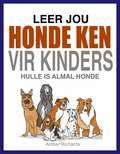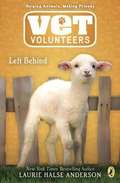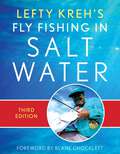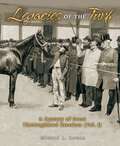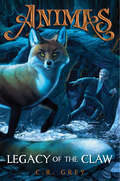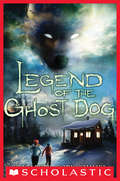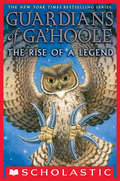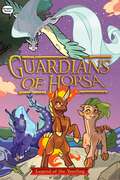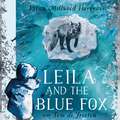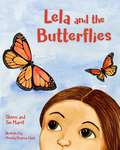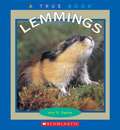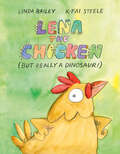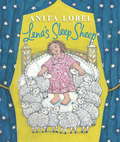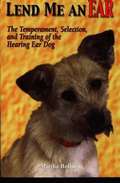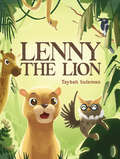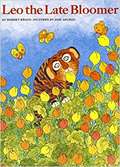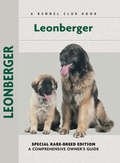- Table View
- List View
Leer Jou Honde Ken (Vir Kinders)
by Amber RichardsHierdie is ‘n boek wat handel oor die veskillende honde rasse. Dit is ‘n e-boek vir jong kinders wat in honde belangstel. Tussen die ouderdomme van 3 en 4 jaar is kinders geneig om die grammatikale reëls van hulle taal te oorveralgemeen. Hulle is geneig om voorwerpe met dieselfde eienskappe as dieselfde voorwerp te klassifiseer. Hierdie boek sal kinders help om te verstaan dat verskillende tipe honde, verkillende rasname het! Die boek bevat 21 verskillende foto's van bekende, sowel as meer onbekende honde rasse. Hierdie is ‘n prettige en leersame boek vir ouers om vir hulle vroeë lesers te lees, of selfs vir jong kinders om self te lees. Hierdie boek kan maklik 'n gesinsgunsteling word. Berei Berei julle snaakste en beste hondgeluide voor!
Left Behind
by Laurie Halse AndersonAnother moving installment in Laurie Halse Anderson's award-winning Vet Volunteers series!When Sunita joins Dr. Gabe and another Vet Volunteer on a house call at a local horse farm, she is concerned to discover a lone lamb housed in one of the stalls. She knows that sheep are flock animals, and that without other sheep and lambs around, this little lamb will not thrive. Can she and her fellow Vet Volunteers help educate the owner, and find a new home for it with others of its kind?
Left Right Emma! (I See I Learn #9)
by Stuart J. MurphyAfter learning the concept of left and right, Emma leads the class marching band on Grandparents Day.
Lefty Kreh's Fly Fishing in Salt Water
by Lefty KrehLefty Kreh&’s original edition of Fly Fishing in Salt Water pioneered a new territory for fly fishers. With over thirty thousand copies sold and the content fully updated, revised, and expanded, this third edition is the saltwater fly fisher&’s bible, based on firsthand experience by an acknowledged master. In clear, practical terms and with helpful photographs and line drawings, Lefty Kreh's Fly Fishing in Salt Water treats the techniques needed to catch all the major saltwater species—bonefish, tarpon, striped bass, bluefish, salmon, permit, snook, sharks, cobia, tuna, billfish, and more. The book shows how to fish from boats and how to wade the flats, and fully explains all the tackle needed and how to use it for specific jobs—the rods, the lines and leaders, and the flies (shown in full color). Lefty provides superb advice about how to make the long casts necessary for fishing the fly in salt water, how to "tease" sailfish and other large fish to within fly-casting range, how to chum, and how to tie the necessary knots for saltwater fishing. Chapter topics include Knots and Leaders, Flies, Tackle, Inshore Fly Fishing, and Boats.
Legacies of the Turf: A Century of Great Thoroughbred Breeders V1
by Edward L. BowenDelve into both the human and equine accomplishments of America&’s greatest twentieth-century breeders in this first volume of Legacies of the Turf. Some of Thoroughbred racing&’s greatest champions—horses such as Man o&’ War, Citation, and Native Dancer—are the handiwork of a remarkable parade of individuals, ranging from full-time horsemen to daring capitalists to philanthropists. In Legacies of the Turf, Volume 1, renowned racing historian Edward L. Bowen tells the stories of some of the powerhouse racing dynasties that dominated the sport in the early to mid-twentieth century—the Whitneys, Vanderbilts, Wideners, Phippses, and Hancocks, as well as the upstarts such as the wily horse trader John E. Madden and the flamboyant Westerner James R. Keene.Women also made their mark as owners and breeders of champion Thoroughbreds. Isabel Dodge Sloane of Brookmeade Stables campaigned the great Sword Dancer, while Gladys Mills Phipps of Wheatley Stable bred and raced the immortal Bold Ruler among her thirteen champions and Helen Hay Whitney of Greentree Stable raced the great Twenty Grand.As horses were bought, sold, and traded, these breeders found success with some of the same bloodlines, as certain sires and dams proved their dominance in the breed. And like the bloodlines of some of their best horses, the lives of many of these great breeders were connected. Given their station in life, some families intermarried, combining racing and breeding interests and making for many interesting stories. August Belmont II and William Collins Whitney were rivals in business before becoming allies on the racetrack. John E. Madden was a mentor for a young Harry Payne Whitney when he first ventured into racing. Here are their stories too.
Legacy of the Claw (Animas #1)
by C. R. GreyTo twelve-year-old Bailey Walker, kin means more than just family. It means being a part of the Animas bond, a harmonious link that connects humans and animals, and guides everything in his world. But Bailey hasn't found his kin yet, and without an Animas, he's destined to be an outsider???or worse, lose his mind entirely. So when he's accepted into the prestigious Fairmount Academy, he's determined to Awaken to his Animas once and for all, even if it's a measly worm. But once there, Bailey can't resist the pull of the dark mysteries surrounding the kingdom. A bear has been viciously attacked on school grounds, and when he and his friends discover signs of a ferocious predator in the woods surrounding campus, he knows something's out there, something dangerous. And Fairmount isn't the only place where darkness is brewing. In the capital city, a new leader preaches that humans must assert power over their kin, enslave them instead of living as one. Bailey can't shake the feeling that the root of the unrest, and the key to his Awakening, lies in an old riddle entwined around an even older prophecy???a prophecy that may reveal the truth about the rightful king of Aldermere. And Bailey may be the only one who can unravel them. The capital's dark forces will stop at nothing to prevent the prophecy from coming true. If they succeed, the Animas bond will be in peril. Can Bailey help protect the Animas bond while still trying to awaken to his own? In this first installment of the gripping ANIMAS series, the battle is just beginning.
Legend of the Ghost Dog
by Elizabeth Cody KimmelA thrilling mystery set against a stark landscape and the inspiration of Nome's real-life dog hero, Balto.Twelve-year-old Tee has just moved to Nome, Alaska, with her writer father and sullen little brother, Jack. Jack isn't happy about the idea of living in the middle of nowhere, but Tee and her dog Henry are thrilled -- so much open space to run around and sniff! But on a walk near their new house, Henry spots something that has him seriously spooked. Tee sees a mysterious shadow, and it seems to be following them. Have they disturbed a restless spirit? And what other secrets might this dark place be holding?
Legend of the Guardians: Legend of the Guardians (Guardians of Ga'Hoole)
by Kathryn LaskyGuardians of Ga'Hoole is a classic hero mythology about the fight between good and evil. This series is filled with adventure, suspense, and heart.When Soren, a young owlet, mysteriously falls from his nest one evening, he's plucked up and taken to the sinister St. Aegolius Academy for Orphaned Owls. Once there, he must use his wits and bravery to escape his captors.The first three books in the Ga'Hoole series follow Soren, Gylfie, Twilight, and Digger, four orphaned owls that must fight their way through many dangers to take refuge with a group of brave owls thought only to be a legend - the Guardians of Ga'Hoole!
Legend of the Yearling (Guardians of Horsa #1)
by Roan BlackIn the first installment of the action-packed Guardians of Horsa graphic novel series, four young horses from clashing herds must join forces to solve a mystery and save magic. <p><p> Welcome to the realm of Horsa, a world of magic, wild horses, and danger. The four elemental herds of Horsa live in uncertain peace, which is to say: stay out of each other’s way and all will be fine. But when signs of a mysterious prophecy about a yearling with untold magical powers appear, four young horses from each herd are called to action. Now these elemental enemies must work together to solve the prophecy, find the yearling, and restore balance to Horsa.
Leila and the Blue Fox
by Kiran Millwood Hargrave'A captivating tale that glistens with wonder. Leila and Fox will always have a home in my heart' Sophie Anderson'This is an extraordinary book - wild and beautiful and perfect. The mess and tangle of humanity is so brilliantly contrasted with the wild spirit of nature' Katya BalenCome with an Arctic fox on a breathtaking journey ... an enthralling story from the bestselling, award-winning creators of Julia and the Shark. With dazzling blue and black illustrations and presented as a deluxe hardback with tracing paper inserts, this is a perfect gift for 9+ fans of The Last Bear and A Wolf Called Wander.She was very tired.She lay down, her soft head on her soft paws.The sunset licked her face.The snow covered her like a blanket.Fox wakes, and begins to walk. She crosses ice and snow, over mountains and across frozen oceans, encountering bears and birds beneath the endless daylight of an Arctic summer, navigating a world that is vast, wild and wondrous. Meanwhile, Leila embarks on a journey of her own - finding her way to the mother who left her. On a breathtaking journey across the sea, Leila rediscovers herself and the mother she thought she'd lost, with help from a determined little fox.Based on the true story of an Arctic fox who walked from Norway to Canada in seventy-six days, a distance of two thousand miles, this compelling, emotional and beautifully illustrated story is the perfect gift for 9+ readers.Praise for Julia and the Shark:'A tale of courage, understanding and compassion' The Observer'Julia and the Shark is deep, beautiful and true. The art shines and the writing soars. A classic from cover to cover' Eoin Colfer'A truly beautiful book, with text and illustrations in perfect harmony. A book to treasure!' Jacqueline Wilson
Leila and the Blue Fox: The perfect gift for every child this Christmas! (Crookhaven #4)
by Kiran Millwood HargraveCome with an Arctic fox on a breathtaking journey ... an enthralling story from the bestselling, award-winning creators of Julia and the Shark. This is a perfect gift for 9+ fans of The Last Bear and A Wolf Called Wander.She was very tired.She lay down, her soft head on her soft paws.The sunset licked her face.The snow covered her like a blanket.Fox wakes, and begins to walk. She crosses ice and snow, over mountains and across frozen oceans, encountering bears and birds beneath the endless daylight of an Arctic summer, navigating a world that is vast, wild and wondrous.Meanwhile, Leila embarks on a journey of her own - finding her way to the mother who left her. On a breathtaking journey across the sea, Leila rediscovers herself and the mother she thought she'd lost, with help from a determined little fox.Based on the true story of an Arctic fox who walked from Norway to Canada in seventy-six days, a distance of two thousand miles, this compelling, emotional and beautifully illustrated story is the perfect gift for 9+ readers.Praise for Julia and the Shark:'A tale of courage, understanding and compassion' The Observer'Julia and the Shark is deep, beautiful and true. A classic from cover to cover' Eoin Colfer'A book to treasure!' Jacqueline Wilson(P) 2022 Hodder & Stoughton Limited
Lela and the Butterflies
by Sherri Maret Tim MaretLela loves butterflies. When Lela takes a nature walk with Ranger Maggie, she learns that butterflies need help. Lela's small steps in butterfly conservation start with a butterfly garden of nectar and host plants, but she doesn't stop there and ends up spreading her love for butterflies throughout the community. A simple guide to planting a butterfly garden is also included.
Lemmings (A True Book)
by Ann O. SquireHow do lemmings survive the long cold winters? What do they eat? And do they really run off cliffs? Find out the answers to these questions and many more in this fact filled book.
Lemurs (Animals)
by Jaclyn JaycoxLemurs are small, furry mammals with big eyes and long tails. Like humans, they are primates. These adorable animals settle their arguments with stink fights! Find out more about these curious creatures.
Lemurs (Nature's Children)
by Lorien KiteDescribes the physical features, habits and habitat of Lemurs. These creatures are native to Madagascar.
Lena the Chicken (But Really a Dinosaur!)
by Linda BaileyChicken Run meets Tiny T. Rex in this funny farmyard tale of a feisty chicken who is sure she is a dinosaur! Includes a die-cut cover — and back matter about how chickens (and all other birds) are the living descendants of dinosaurs!Lena lives in a chicken coop, and she looks a lot like a chicken. But deep down, she&’s convinced that she&’s a . . . DINOSAUR! She can feel it in her bones. Lena just doesn&’t understand the scaredy chickens in her family, and they don't understand her either, with her ferociousness and big ideas. The people on the farm are also baffled . . . except for little Madeline, who thinks Lena has PERSONALITY. And then, when a dastardly weasel turns up and threatens the coop, Lena's fearful family chickens out AGAIN. It's up to Lena to unleash her inner dinosaur like never before — to save the coop and show this silly bunch of chickens how to stand up for themselves. And when Madeline's science fair project shows that chickens are the closest living relatives in the world to dinosaurs, Lena&’s family finally starts to see that — holy hen house! — they are all dinosaurs too!
Lena's Sleep Sheep
by Anita LobelAfter a hug and kiss from Mama and Papa, Lena is cozy in her bed and ready for her sleep sheep to help her fall asleep. But the sheep refuse to line up and be counted!"We're sca-a-a-a-red!" the sheep baa together. "There's a round monster in the window, making faces at us. He looks hungry and ready for a sheep snack."Lena's sheep are afraid of the full moon shining through her window. Can clever Lena help these silly sheep overcome their fears so that she can get a good night's sleep?
Lend Me An Ear
by Martha HoffmanLend Me an ear is a remarkable book that helps one to evaluate the temperament of dogs- specifically shelter castaways for the purpose of training as hearing dogs. The book delves into temperaments that work and do not work along with providing instruction on how to train various skills needed for the dog to alert its partner.
Lenny the Lion
by Taybah SulemanA young lion cub embarks on a thrilling journey through the desert, safari, jungle and forest in hope to find his lion pack whilst meeting some fascinating animal friends along the way… Lenny the Lion is an enticing book teaching children the importance of resilience, overcoming obstacles and the value of friendship.
Leo the Late Bloomer
by Robert KrausLeo isn't reading, or writing, or drawing, or even speaking, and his father is concerned. But Leo's mother isn't. She knows her son will do all those things, and more, when he's ready.
Leo the Lucky Kitten (Kitten Friends #5)
by Jenny DaleLeo tumbles out of a tree, gets stuck in a shed, and falls into a pond. When will his luck change?
Leonard & Loulou
by Esther BuerkiA friendship between a boy and a talking cat leads to a magical adventure—and reveals some important secrets. When Leonard wakes up one morning, a cat is sitting on his bed. Then the cat begins to talk—and Leonard soon confides in his new friend, Loulou, that he really doesn&’t want to go to school this morning. He&’s not very happy there. Thus begins the start of a wonderful friendship . . . Loulou will take Leonard to the world of cats and dogs and teach him how to be more self-confident—while Leonard teaches the cats and dogs how human beings express their feelings. Esther Buerki started writing this charming story when her own son didn&’t want to go to school and would have preferred to stay at home with his little cat. Leonard & Loulou helps young children and adults alike to speak about their emotions, even about difficult subjects like bullying and feelings of inadequacy, and encourages a message of self-esteem
Leonberger (Comprehensive Owner's Guide)
by Michael Trafford Madeline LusbyThis "Special Rare-Breed Edition" on the Leonberger is the most comprehensive new owner's guide available on "the lion of the dog world." <P><P>A relative newcomer to the American Kennel Club, the Leonberger has been a European favorite for years, revered for his impressive size (over 30 inches at the shoulder), his long mane of a coat, and his tawny, golden coat. The Leonberger is a unique German creation, a dog that is as courageous and handsome as the king of the jungle but also a mild-mannered, affectionate home companion. He is prized as a watchdog-as his roar is bigger than his bite-and his much-loved family is well protected when the Leo is on duty.New owners and those intrigued by this handsome German breed will welcome the information provided on selection of a puppy, training, feeding, and general maintenance. The chapters on history, characteristics, and the breed standard prove an ideal introduction to breed. The author, Madeline Lusby, is a Leo breeder and owner, and her many anecdotes and first-hand experience with Leonbergers provide valuable insight into the temperament and inner workings of the breed.Subsequent chapters offer helpful information on shopping for puppy supplies, puppy-proofing the home, socialization, housetraining, basic obedience lessons, feeding, coat care and more. The health chapter discusses parasite prevention, inoculations, and finding the most qualified veterinarian for a giant breed. Sidebars throughout offer helpful advice to readers about dozens of topics.
Leopard Geckos For Dummies
by Liz PalikaGet your one-stop guide for understanding and raising this popular pet lizard. Reptiles are now kept in one out of every seven pet homes, so it's no surprise that millions have gone gaga for geckos. This fun, easy-to-follow guide provides the scoop on caring for these colorful, gentle creatures, with savvy tips on everything from diet and exercise to housing and veterinary care. The book covers how to properly handle a gecko, what to do if a gecko drops his tail, how to keep the right cage temperatures, ways to protect geckos from other pets, and where to find the best supplies. Liz Palika (Oceanside, CA) is an award-winning pet writer with more than 45 books to her credit, including Turtles & Tortoises For Dummies.
Leopard Seals
by Sandra MarkleAges 8-12 Weighing in at about 800 pounds (363 kilograms), the leopard seal has a hard time moving around on land. But in the water, few animals stand a chance against this amazing predator. The leopard seal hunts among the ice flows of the Antarctic, catching fish, krill, and penguins. Its speckled gray coat helps it blend in with the waves while it hunts. Its whiskers pick up vibrations in the water to help it find its prey. And its pointed, inch-long (2.5-centimeter) teeth make it a match for any animal that crosses its path. All of these features make the leopard seal one of the most effective predators of the Antarctic.
